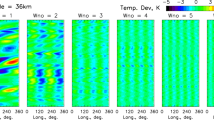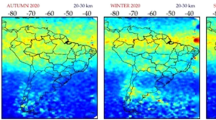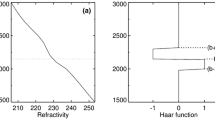Abstract
GPS radio occultation (GPS RO) method, an active satellite-to-satellite remote sensing technique, is capable of producing accurate, all-weather, round the clock, global refractive index, density, pressure, and temperature profiles of the troposphere and stratosphere. This study presents planetary-scale equatorially trapped Kelvin waves in temperature profiles retrieved using COSMIC (Constellation Observing System for Meteorology, Ionosphere, and Climate) satellites during 2006–2009 and their interactions with background atmospheric conditions. It is found that the Kelvin waves are not only associated with wave periods of higher than 10 days (slow Kelvin waves) with higher zonal wave numbers (either 1 or 2), but also possessing downward phase progression, giving evidence that the source regions of them are located at lower altitudes. A thorough verification of outgoing longwave radiation (OLR) reveals that deep convection activity has developed regularly over the Indonesian region, suggesting that the Kelvin waves are driven by the convective activity. The derived Kelvin waves show enhanced (diminished) tendencies during westward (eastward) phase of the quasi-biennial oscillation (QBO) in zonal winds, implying a mutual relation between both of them. The El Niño and Southern Oscillation (ENSO) below 18 km and the QBO features between 18 and 27 km in temperature profiles are observed during May 2006–May 2010 with the help of an adaptive data analysis technique known as Hilbert Huang Transform (HHT). Further, temperature anomalies computed using COSMIC retrieved temperatures are critically evaluated during different phases of ENSO, which has revealed interesting results and are discussed in light of available literature.
Similar content being viewed by others
References
Alexander, M. J., and J. R. Holton, 1997: A model study of zonal forcing in the equatorial stratosphere by convectively induced gravity waves. J. Atmos. Sci., 54, 408–419.
Alexander, S. P., T. Tsuda, Y. Kawatani, et al., 2008: Global distribution of atmospheric waves in the equatorial upper troposphere and lower stratosphere: COSMIC observations of wave mean flow interactions. J. Geophys. Res., 113, D24115.
Angell, J. K., and J. Korshover, 1964: Quasibiennial variations in temperature, total ozone, and tropopause height. J. Atmos. Sci., 21, 479–492.
Anthes, R. A., D. Ector, D. C. Hunt, et al., 2008: The COSMIC/FORMOSAT-3 mission: Early results. Bull. Amer. Meteor. Soc., 89, 313–333.
—, 2011: Exploring earth’s atmosphere with radio occultation: Contributions to weather, climate, and space weather. Atmos. Meas. Tech., 4, 1077–1103.
Ao, C. O., G. A. Hajj, T. K. Meehan, et al., 2009: Rising and setting GPS occultations by use of open-loop tracking. J. Geophys. Res., 114, D04101, doi: 10.1029/2008JD010483.
Baldwin, M. P., L. J. Gray, T. J. Dunkerton, et al., 2001: The quasi-biennial oscillation. Rev. Geophys., 39, 179–229.
Brahmanandam, P. S, Y. H. Chu, and J. Liu, 2010: Observations of equatorial Kelvin wave modes in FORMOSAT-3/COSMIC GPS RO temperature profiles. Terr. Atmos. Ocean. Sci., 21(5), 829–840.
—, Y. H. Chu, K.-H. Wu, et al., 2011: Vertical and longitudinal electron density structures of equatorial Eand F-regions. Ann. Geophys., 29, 81–89.
—, U. Gouthu, J. Y. Liu, et al., 2012: Global S4 index variations observed using FORMOSAT-3/COSMIC GPS RO technique during a solar minimum year. J. Geophys. Res., 117, A09322, doi: 10.1029/2012JA017966.
Canziani, P. O., J. R. Holton, E. F. Fishbein, et al., 1994: Equatorial Kelvin waves: A UARS MLS view. J. Atmos. Sci., 51, 3053–3076.
—, and J. R. Holton, 1998: Kelvin waves and the quasibiennial oscillation: An observational analysis. J. Geophys. Res., 103, 31509–31521.
Chu, Y.-H., P. S. Brahmanandam, C.-Y. Wang, et al., 2011: Coordinated sporadic E-layer observations made with Chung-Li 30 MHz radar, ionosonde and FORMOSAT-3/COSMIC satellites. J. Atmos. Terr. Phys., 73, 883–894.
Dunkerton, T. J., 1997: The role of gravity waves in the quasi-biennial oscillation. J. Geophys. Res., 102, 26053–26076.
Ern, M., P. Preusse, M. Krebsbach, et al., 2008: Equatorial wave analysis from SABER and ECMWF temperatures. Atmos. Chem. Phys., 8, 845–869.
Evan, S., M. J. Alexander, and J. Dudhia, 2012: WRF simulations of convectively-generated gravity waves in opposite QBO phases. J. Geophys. Res., 117, 1–17.
Fjeldbo, G., A. J. Kliore, and V. R. Eshleman, 1971: The neutral atmosphere of Venus as studied with the Mariner V radio occultation experiments. The Astronomical Journal, 76, 123–140.
Fujiwara, M., K. Kita, and T. Ogawa, 1998: Stratosphere-troposphere exchange of ozone associated with the equatorial Kelvin wave as observed with ozonesondes and rawinsondes. J. Geophys. Res., 103, 19173–19182.
—, F. Hasebe, M. Shiotani, et al., 2001: Water vapor control at the tropopause by equatorial Kelvin waves observed over the Galápagos. Geophys. Res. Lett., 28, 3143–3146.
—, S.-P. Xie, M. Shiotani, et al., 2003: Uppertropospheric inversion and easterly jet in the tropics. J. Geophys. Res., 108, 4796, doi: 10.1029/2003JD003928.
Garcia, R. R., and M. L. Salby, 1987: Transient response to localized episodic heating in the tropics. Part II: Far-field behavior. J. Atmos. Sci., 44, 499–532.
Hajj, G. A., C. O. Ao, B. A. Iijima, et al., 2004: CHAMP and SAC-C atmospheric occultation results and intercomparisons. J. Geophys. Res., 109, doi: 10.1029/2003JD003909.
Highwood, E. J., and B. J. Hoskins, 1998: The tropical tropopause. Quart. J. Roy. Meteor. Soc., 124, 1579–1604.
Hitchman, M. H., and C. B. Leovy, 1988: Estimation of the Kelvin wave contribution to the semiannual oscillation. J. Atmos. Sci., 45, 1462–1475.
Holton, James R., and R. S. Lindzen, 1972: An updated theory for the quasi-biennial cycle of the tropical stratosphere. J. Atmos. Sci., 29, 1076–1080.
Huang, N. E., Z. Shen, S. R. Long, et al., 1998: The empirical mode decomposition and the Hilbert spectrum for nonlinear and non-stationary time series analysis. Proc. R. Soc. Lond. A, 454, 903–993, doi: 10.1098/rspa.1998.0193.
—, and Z. H. Wu, 2008: A review on Hilbert-Huang Transform: Method and its applications to geophysical studies. Rev. Geophys., 46, RG2006, doi: 10.1029/2007RG000228.
Kawatani, Y., S. Watanabe, K. Sato, et al., 2010: The roles of equatorial trapped waves and internal inertia-gravity waves in driving the quasi-biennial oscillation. Part I: Zonal mean wave forcing. J. Atmos. Sci., 67(4), 963–980.
Kishore, P., S. P. Namboothiri, J. H. Jiang, et al., 2009: Global temperature estimates in the troposphere and stratosphere: A validation study of COSMIC/FORMOSAT-3 measurements. Atmos. Chem. Phys., 9, 897–908.
Lindzen, R. S., 2003: The interaction of waves and convection in the tropics. J. Atmos. Sci., 60, 3009–3020.
Mannucci, A. J., S. T. Lowe, C. O. Ao, et al., 2012: New science opportunities on COSMIC-2/FORMOSAT-7. Sixth COSMIC/FORMOSAT-3 Data User’s Workshop, Boulder, Colorado, USA.
Melbourne, W. G., E. S. Davis, G. A. Hajj, et al., 1994: The Application of Spaceborne GPS to Atmospheric Limb Sounding and Global Change Monitoring. JPL Publication, 147 pp.
Mote, P. W., T. J. Dunkerton, and D. Wu, 2002: Kelvin waves in stratospheric temperature observed by the Microwave Limb Sounder. J. Geophys. Res., 107(D14), 4218.
Pires, P., J.-L. Redelsperger, and J.-P. Lafore, 1997: Equatorial atmospheric waves and their association to convection. Mon. Wea. Rev., 125, 1167–1184.
Potula, B. S., Y.-H. Chu, G. Uma, et al., 2011: A global comparative study on the ionospheric measurements between COSMIC radio occultation technique and IRI model. J. Geophys. Res., 116, A02310, doi: 10.1029/2010JA015814.
Randel, W. J., F. Wu, and W. Rivera Ríos, 2003: Thermal variability of the tropical tropopause region derived from GPS/MET observations. J. Geophys. Res., 108(D1), 4024, doi: 10.1029/2002JD002595.
—, and —, 2005: Kelvin wave variability near the equatorial tropopause observed in GPS radio occultation measurements. J. Geophys. Res., 110, doi: 10.1029/2004JD005006.
—, K. P. Shine, J. Austin, et al., 2009: An update of observed stratospheric temperature trends. J. Geophys. Res., 114, D02107, doi: 10.1029/2008JD010421.
Rao, D. N., M. Venkat Ratnam, S. K. Mehta, et al., 2009: Validation of the COSMIC radio occultation data over Gadanki (13.48°N, 79.2°E): A tropical region. Terr. Atmos. Ocean. Sci., 20, 59–70.
Ratnam, M. V., T. Tsuda, T. Kozu, et al., 2006: Longterm behavior of the Kelvin waves revealed by CHAMP/GPS RO measurements and their effects on the tropopause structure. Ann. Geophys., 24, 1355–1366.
Salby, M. L., D. L. Hartmann, P. L. Bailey, et al., 1984: Evidence for equatorial Kelvin modes in Nimbus-7 LIMS. J. Atmos. Sci., 41, 220–235.
—, and R. R. Garcia, 1987: Transient response to localized episodic heating in the tropics. Part I: Excitation and short-time near-field behavior. J. Atmos. Sci., 44, 458–498.
Sasi, M. N., and V. Deepa, 2001: Seasonal variation of equatorial wave momentum fluxes at Gadanki (13.5°N, 79.2°E). Ann. Geophys., 19, 985–990, doi: 10.5194/angeo-19-985-2001.
Scherllin-Pirscher, B., C. Deser, S.-P. Ho, et al., 2012: The vertical and spatial structure of ENSO in the upper troposphere and lower stratosphere from GPS radio occultation measurements. Geophys. Res. Lett., 39, L20801, doi: 10.1029/2012GL053071.
Seidel, D. J., R. J. Ross, J. K. Angell, et al., 2001: Climatological characteristics of the tropical tropopause as revealed by radiosondes. J. Geophys. Res., 106, 7857–7878.
Shiotani, M., and T. Horinouchi, 1993: Kelvin wave activity and the quasi-biennial oscillation in the equatorial lower stratosphere. J. Meteor. Soc. Japan., 71, 175–182.
—, J. C. Gille, and A. E. Roche, 1997: Kelvin waves in the equatorial lower stratosphere as revealed by cryogenic limb array etalon spectrometer temperature data. J. Geophys. Res., 102, 26131–26140.
Smith, A. K., P. Preusse, and J. Oberheide, 2002: Middle atmosphere Kelvin waves observed in Cryogenic infrared Spectrometers and Telescopes for the Atmosphere (CRISTA) 1 and 2 temperature and trace species. J. Geophys. Res., 107, doi: 10.1029/2001JD000577.
Sridharan, S., T. Tsuda, T. Nakamura, et al., 2006: Observations of the 7-day Kelvin wave in the tropical atmosphere during the CPEA campaign. J. Meteor. Soc. Japan, 84a, 259–275.
Steiner, A. K., B. C. Lackner, F. Ladstädter, et al., 2011: GPS radio occultation for climate monitoring and change detection. Radio Sci., 46, RS0D24, doi: 10.1029/2010RS004614.
Sun, B. M., A. Reale, D. J. Seidel, et al., 2010: Comparing radiosonde and COSMIC atmospheric profile data to quantify differences among radiosonde types and the effects of imperfect collocation on comparison statistics. J. Geophys. Res., 115, D23104.
Tindall, J. C., J. Thuburn, and E. J. Highwood, 2006a: Equatorial waves in the lower stratosphere. Part I: A novel detection method. Quart. J. Roy. Meteor. Soc., 132, 177–194.
—, —, —, 2006b: Equatorial waves in the lower stratosphere. Part II: Annual and interannual variability. Quart. J. Roy. Meteor. Soc., 132, 195–212.
Tsuda, T., Y. Murayama, H. Wiryosumarto, et al., 1994: Radiosonde observations of equatorial atmosphere dynamics over Indonesia: 1. Equatorial waves and diurnal tides. J. Geophys. Res., 99, 10491–10505.
Uma, G., J. Y. Liu, S. P. Chen, et al., 2012: A comparison of the equatorial spread F derived by the international reference ionosphere and the S4 index observed by FORMOSAT-3/COSMIC during the solar minimum period of 2007–2009. Earth Planets Space, 64, 467–471.
Wallace, J. M., and V. E. Kousky, 1968: Observational evidence of Kelvin waves in the tropical stratosphere. J. Atmos. Sci., 25, 900–907.
Wheeler, M., and G. N. Kiladis, 1999: Convectively coupled equatorial waves: Analysis of clouds and temperature in the wavenumber-frequency domain. J. Atmos. Sci., 56, 374–399.
Wickert, J., C. Reigber, G. Beyerle, et al., 2001: Atmosphere sounding by GPS radio occultation: First results from CHAMP. Geophys. Res. Lett., 28(17), 3263–3266.
Wu, Z., N. Huang, and Y. Chen, 2009: The multidimensional ensemble empirical mode decomposition method. Advances in Adaptive Data Analysis, 1, 339–372.
Yang, G. Y., and B. Hoskins, 2013: ENSO impact on Kelvin waves and associated tropical convection. J. Atmos. Sci., doi: 10.1175/JAS-D-13-081.1.
Zhang, K., E. Fu, D. Silcock, et al., 2011: An investigation of atmospheric temperature profiles in the Australian region using collocated GPS radio occultation and radiosonde data. Atmos. Meas. Tech., 4, 2087–2092.
Zeng, Z., S.-P. Ho, S. Sokolovskiy, et al., 2012: Structural evolution of the Madden-Julian Oscillation from COSMIC radio occultation data. J. Geophys. Res., 117, D22108.
Author information
Authors and Affiliations
Corresponding author
Additional information
Supported by the Science Council of Taiwan (NSC-101-2811-M-008-012).
Rights and permissions
About this article
Cite this article
Anisetty, S.K.A.V.P.R., Brahmanandam, P.S., Uma, G. et al. Planetary-scale wave structures of the earth’s atmosphere revealed from the COSMIC observations. J Meteorol Res 28, 281–295 (2014). https://doi.org/10.1007/s13351-014-0101-y
Received:
Accepted:
Published:
Issue Date:
DOI: https://doi.org/10.1007/s13351-014-0101-y




